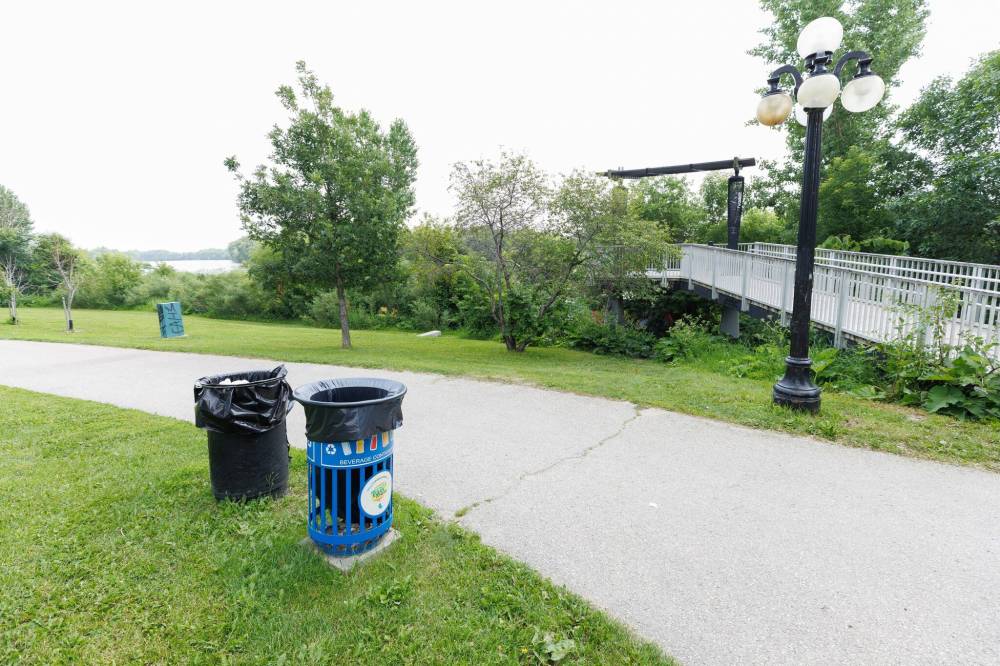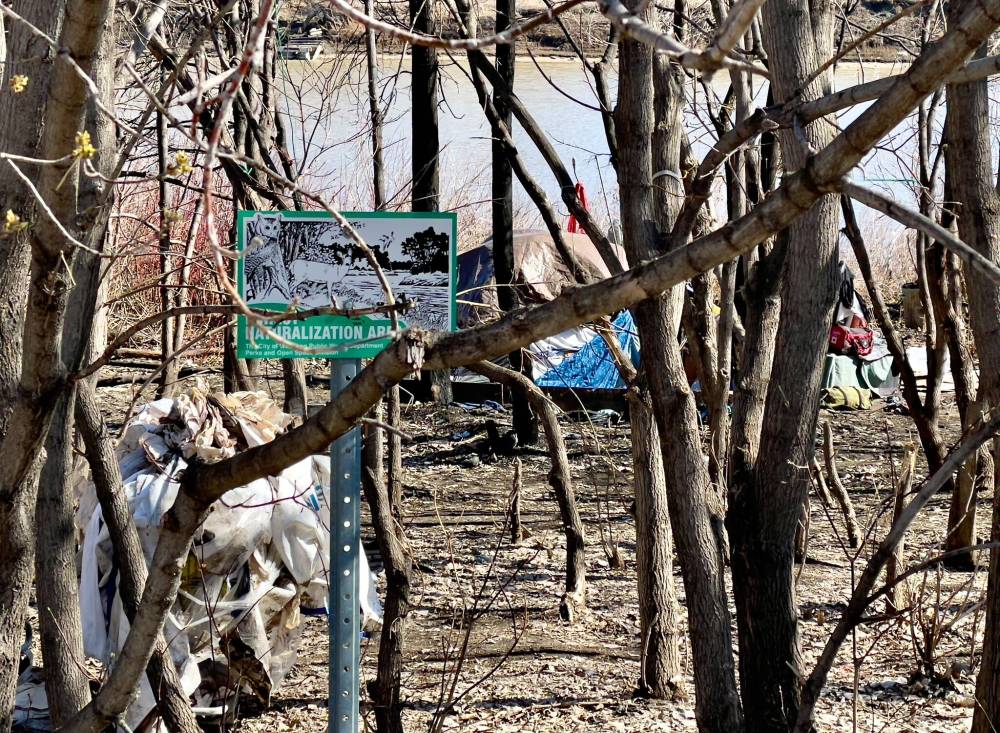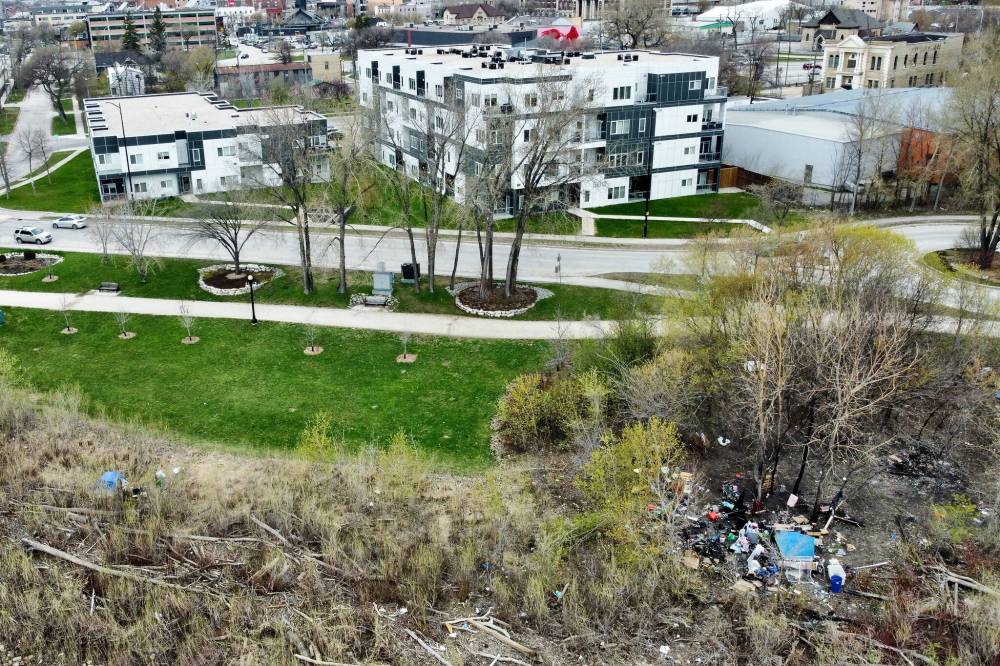One month into weekly garbage pickups at three Winnipeg homeless encampments, a few thousand gallons of trash have been removed, though some neighbours aren’t sure the sites are much cleaner.
About 3,880 gallons (14,687 litres) of garbage was collected from encampments at Assiniboine Avenue, Waterfront Drive and Maple Street since the pickups began around June 10, Sherwood Armbruster, the City of Winnipeg’s interim chief administrative officer, said.
“We’ve still got a ways to go through the summer but the early signs are very encouraging, as far as the collaboration … There’s been some early positive signs and lessons learned,” said Armbruster.

MIKE DEAL / FREE PRESS
A no-tent sign is lost amongst the undergrowth along Waterfront Drive, metres from several tents along the Red River. About 3,880 gallons (14,687 litres) of garbage have been cleaned up since June 10 at the Waterfront encampments and others in the city.
The pilot project to clean up the areas relies on non-profit organization Main Street Project to reach out to encampment residents. Every week, the Downtown Community Safety Partnership distributes garbage bags and returns to pick up the bags the next day, after those living at the sites fill them.
Siloam Mission conducts larger cleanups, such as when an entire encampment is abandoned, while the city helps co-ordinate the effort and provides $170,000 to cover the costs, said Armbruster.
“There’s many organizations involved and there’s often different views and there are bumps along the way but … everybody wants to see something better,” he said.
Mayor Scott Gillingham said it’s too soon to say if the cleanups have made the three encampments cleaner or if the pilot should lead to permanent garbage collection at such sites.

MIKE DEAL / FREE PRESS
Extra garbage bins line the sidewalk along Waterfront Drive where tents can be seen peeking through the underbrush.
“I don’t have the answer to that question at this point. Residents who live near encampments have expressed concern about the need for cleanup … (And) we want to make sure individuals who are living in encampments get dignified treatment and the service that they need to meet their needs,” he said.
The mayor stressed the overall response to homelessness must focus on supplying more housing with social supports.
”The garbage is a big problem but the biggest problem is that there’s people living on the river”–Laurie Nealin
An Exchange District resident who lives near the Waterfront Drive encampment said she’s not sure if the cleanups have made a difference. Laurie Nealin said two of her neighbours spent three hours cleaning trash from one abandoned encampment last weekend, removing many garbage bags worth of trash and six shopping carts.
“My question (is): Why are my neighbours spending three hours doing this back-breaking work, when supposedly there is this program?” said Nealin.

Supplied
The garbage in the Fort Douglas Park encampment, seen here in April 2024, is one of the sites targeted by the municipal garbage pick-up program.
She said some areas, such as Fort Douglas Park near the Alexander Docks, tend to accumulate so much trash, volunteer garbage collectors within the neighbourhood have given up on cleaning them.
“Even if they did something, the next day or three days later, it’s going to look like they weren’t even there,” said Nealin.
Fort Douglas Park contained several tents on Wednesday, along with some broken tree limbs and torn up cardboard boxes.
Nealin stressed encampments aren’t safe or healthy for those who live in them, lacking basic amenities like bathrooms, so the focus must always be on trying to find vulnerable people permanent housing.
“The garbage is a big problem but the biggest problem is that there’s people living on the river … You can’t make a step forward … when you’re trying to survive living on the riverbank,” said Nealin.
An agency tasked with picking up the trash for the pilot project said staff do attempt to connect people with housing.
“This (program) is addressing cleanliness and the immediate care of the encampment … But if they are looking for long-term services and supports, then (Downtown Community Safety Partnership’s) Clean Slate team can refer (encampment residents) to our other teams … to help out with housing, addiction services, whatever needs (are there),” said Matt Halchakar, director of operations for the safety partnership.

Supplied
The pilot project to clean up the areas relies on non-profit organization Main Street Project to reach out to encampment residents. Every week, the Downtown Community Safety Partnership distributes garbage bags and returns to pick up the bags the next day, after those living at the sites fill them.
Halchakar said the outreach effort includes asking homeless people questions about housing, not just responding when they raise the topic.
“We’re definitely going out and offering our services, not just waiting until it’s asked for,” he said.
Halchakar said encampment residents have responded well to the garbage pickups and more frequent pickups could be considered in the future, if trash still accumulates.

Supplied
The Waterfront Drive encampment is seen in May 2024. Winnipeg Mayor Scott Gillingham has stressed the overall response to homelessness must focus on supplying more housing with social supports.
Kendall Giilck, a building futures employment program manager for Siloam Mission, said encampment residents asked for regular trash pickups before the program started.
“They were expressing that they would like to be able to clean up those sites that they were living in, so that they could live in clean and dignified spaces,” said Giilck.
She said Siloam has seen a visual improvement at the three sites and positive feedback since the pilot program started.
“So far, the reports that we’ve seen have been really positive, from the encampment residents themselves and anyone whose spoken (to us) about the sites that we’ve been servicing,” said Giilck.
Main Street Project declined comment.
joyanne.pursaga@freepress.mb.ca
X: @joyanne_pursaga

Joyanne Pursaga
Reporter
Joyanne is city hall reporter for the Winnipeg Free Press. A reporter since 2004, she began covering politics exclusively in 2012, writing on city hall and the Manitoba Legislature for the Winnipeg Sun before joining the Free Press in early 2020. Read more about Joyanne.
Every piece of reporting Joyanne produces is reviewed by an editing team before it is posted online or published in print — part of the Free Press‘s tradition, since 1872, of producing reliable independent journalism. Read more about Free Press’s history and mandate, and learn how our newsroom operates.
Our newsroom depends on a growing audience of readers to power our journalism. If you are not a paid reader, please consider becoming a subscriber.
Our newsroom depends on its audience of readers to power our journalism. Thank you for your support.